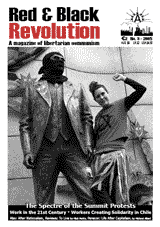Over 30 years of anarchist writing from Ireland listed under hundreds of topics
Book Review: To Live
For many people the 'civil war' within the Civil War that occurred in Spain between 1936-39 is a difficult business to understand. Not only were many different organisations involved, but it was set against the background of an even larger conflict that in itself was rife with brutality and betrayal. Although it appears at times to be an impossible quagmire to make sense of, Mick Parkin has succeeded admirably in his short novel To Live.Mick Parkin will be known to some that read these pages as the one-time publisher of Sinews, the English-language publication which played a valuable role in publishing articles on the split in the CNT in the 80s. Parkin is a fluent Spanish speaker and has lived for many years in Spain. He now resides in Scotland where he is a member of the Scottish Socialist Party.
To Live begins with the theft of twelve tanks from the production line at a metal works plant operated by POUM aligned workers in April 1937. The CNT, the anarchist aligned general union of workers, appoints two of its members, Ramon Alvares and Vicente Rossell, to investigate what has happened. Ramon is recently returned from Zaragossa Front while Vicente is a worker in the Co-operitiva Vigor, a worker-run factory. As the story follows the movements and discoveries of these two comrades we get a wider picture of balance of views and ideas at the crucial time in the course of the Spanish Revolution.
To Live does not waste a lot of time with detail - an achievement in itself given the large amount of information that is still conveyed to the reader through dialogue and descriptions about situations and places. It moves swiftly between the main characters' investigative work and their personal lives, giving the book the quality of a good, fast-moving read. One of Parkin's strengths is dialogue, and this is cleverly used to convey a sense of the debate that is raging about the future course of the revolution.
The story begins in late April 1937 and closes just as the main Telephone Exchange in Barcelona is attacked by the Guardia Civil at the behest of Stalinist PSUC - an event that was to mark the end of revolution in Spain. In the interval we catch a glimpse of what life might possibly have been like for the many participants who struggle admirably during those days to change the course of history. What emerges is a world under siege, where the more far-sighted are able to see the dangers that are approaching but are unable to do what is needed to affect the necessary change. The story of the Spanish Civil War? Hardly so, but in some respects we do see another dimension to the struggle here, and that is useful.
I wasn't too happy with the end - nothing to do with the politics as such - but this doesn't distract from what is a good book about a time we rarely see represented in fiction. Contact the author by email (mickmcparkin@aol.com) to get a copy of this book.
Read more about the Spanish Revolution
This article is from Red and Black Revolution 9, published Summer 2005


